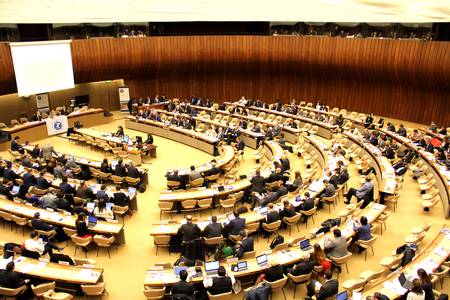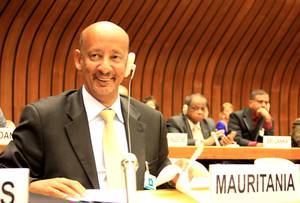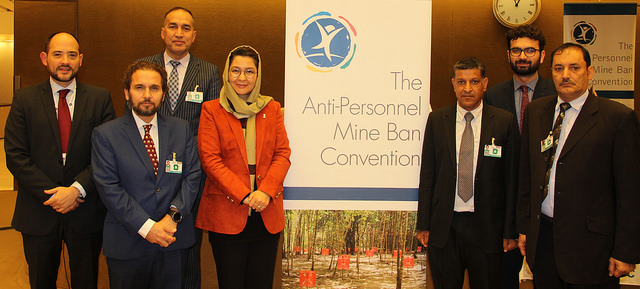30.11.2018

Download the press release

Geneva - The Anti-Personnel Mine Ban Convention's Seventeenth Meeting of the States Parties (17MSP) concluded in Geneva recording success in stockpile destruction and mine clearance in the Middle East and West Africa.
While progress was welcome, the Conference agreed that new contamination by anti-personnel mines of an improvised nature should be reported and treated under the Convention in the same manner as factory-made mines.
Key messages
Afghanistan which chaired the Convention throughout 2018, called on the Parties to actively recognise the increasing threat of anti-personnel mines of an improvised nature, mostly in use by armed non-state actors, which has driven up the global figures of casualties.
“Countering the threat of improvised explosive devices (IEDs) which killed over 2,200 Afghans in 2017 alone, is an imperative being pursued by Afghanistan nationally and internationally,” said the Afghan Presidency of the treaty.
Afghanistan reported 2,288 mine casualties in 2017 including 159 women, 866 men, and 1,263 children. Of these, 793 persons were killed.
 Special Envoy of the Convention HRH Prince Mired Raad Zeid Al-Hussein, called on mine-affected countries including those affected by weapons of an improvised nature to embrace the concept of ownership and “take the issue at hand very seriously.”
Special Envoy of the Convention HRH Prince Mired Raad Zeid Al-Hussein, called on mine-affected countries including those affected by weapons of an improvised nature to embrace the concept of ownership and “take the issue at hand very seriously.”
The growing use of anti-personnel mines of an improvised nature is also a concern of the incoming Norwegian presidency.
HRH Prince Mired Raad Zeid Al-Hussein (left)
H.E. Hans Brattskar, Ambassador of Norway to the UN in Geneva (right)
“Let me be clear: anti-personnel mines are prohibited and fall under the obligations of this Convention, independent of whether they are manufactured or improvised,” added H.E. Hans Brattskar, Ambassador of Norway to the UN in Geneva.
The Conference involved over 600 participants representing over 120 delegations including 113 States (100 States Parties plus 13 Observers that have not yet joined), and 22 international and non-governmental organisations, many representing landmine survivors' interests.
Successes
- Mauritania declared that after nearly two decades of work (and four decades since these weapons were laid), it had cleared all its known mined zones. Mauritania indicated that it financed 68% of its own mine clearance while donor countries and UN agencies contributed the remainder.
- With Mauritania 31 of 60 States Parties have completed their mine clearance obligation.
- Oman declared having fulfilled its stockpile destruction obligation earlier than its deadline. Oman which joined the Convention as recently as 2015, indicated it had destroyed its stocks in an environmentally friendly manner without affecting wildlife or water sources.
Left: Mr. Alioune Ould Menane declaring Mauritania's completion of its mine clearance obligation.
Right: Colonel Yahya Adbulla Sulaiman Al Amri of Oman after declaring Oman as having fulfilled its stockpile destruction obligation together with the 17MSP Chair Ambassador Suraya Dalil, the delegation of Afghanistan, HRH Prince Mired of Jordan and ISU Director.
- With Oman, the States Parties have destroyed in excess of 51 million anti-personnel mines; 161 of 164 States no longer have stockpiling destruction obligations under the Convention.
- Greece has faced a unique challenge since 2014 when a deadly explosion occurred at a Bulgarian facility where its stocks were being destroyed. The accident halted Greece’s efforts requiring the stocks to be transferred back to Greece. The transfer took several years due to safety consideration; Bulgaria has now however, sent 190,000 mines back to Greece. Further, Greece has successfully restarted its destruction process reducing by more than 100,000 its stockpile, hoping to destroy an additional 60,000 mines by year’s end.
Challenges that remain on mine clearance

Mine clearance in Serbia. Photo courtesy of the Serbian Mine Action Center, SMAC
- Thirty States Parties are still carrying out mine clearance, including some of the most mine-affected in the world which could go beyond the established 2025 mine-free ambition.
- Two of the most mine-affected countries in the world, Afghanistan and Iraq, have seen an increase in landmine contamination due to armed non-state actors’ use of anti-personnel mines of an improvised nature.
- Seven States Parties that indicated not being able to meet their 2019 deadlines requested additional time for clearance including,
- Bosnia and Herzegovina – The Meeting noted that it is unfortunate that after almost twenty years since entry into force BiH is unable to specify how much work remains and how it will be carried out; BiH was granted until 1 March 2021 to continue its mine clearance efforts and acquire a clearer understanding of the remaining challenge to submit a final plan for completion.
- Croatia – The Meeting noted that even with a consistent and sizeable effort going back even before entry into force of the Convention, Croatia faces a significant remaining challenge and granted until 1 March 2026. While the date goes beyond the 2025 mine-free ambition Croatia declared it would finalise by 31 December 2025.
- Cyprus – The Meeting noted that Cyprus indicated the sole circumstance impeding its ability to destroy all anti-personnel mines is that the areas are not under its effective control, and granted Cyprus until 1 July 2022. Cyprus has been asked to inform on any changes on status of control of mined areas.
- Serbia – While the Meeting noted that Serbia had not been able to complete implementation of its mine clearance obligation during its extended deadline, it recognised Serbia had made commendable progress and granted a new deadline for 1 March 2023 with reports in 2020 and 2022.
- Sudan – While the Meeting agreed that mine clearance may be affected by the security situation and noted that Sudan had not been able to complete implementation of its mine clearance obligation during its extended deadline, it considered Sudan has made considerable progress and granted until 1 April 2023 submitting reports in 2020 and 2022.
- United Kingdom – The Meeting noted that clarity concerning the remaining challenge at Yorke Bay is pending technical survey which results may only be available in early 2019; therefore it requested that the United Kingdom submit updated work plans by 2020 and 2022 and granted a new deadline of 1 March 2024.
- Ukraine – The Meeting recognises that the only reason which impedes destruction of anti-personnel mines in mined zones is that Ukraine has no effective control over them and granted a request until 1 June 2021. During the course of this period Ukraine has been asked to keep States Parties informed on the status of control of mined areas.

Other challenges
- Ukraine faces a particular challenge in meeting its deadline, as most of the stock it has to destroy is of the PFM-1 type -- mines which are extremely hazardous and pose serious technical difficulties to destroy.
- 34 States have not yet ratified or acceded to the Convention. Combined six of them – China, India, the Republic of Korea, Pakistan, Russia and the United States – may hold tens of millions of stockpiled antipersonnel mines. All of these but Korea and Russia attended the Convention as Observers and have expressed agreement with the Convention’s humanitarian objectives. The United States is the largest mine action donor in the world.
- While the majority of landmine victims are in a better position than before the Convention entered into force, much more needs to be done to address their needs and rights.
For more information contact the Convention's Implementation Support Unit: isu(at)apminebanconvention.org




 Special Envoy of the Convention HRH Prince Mired Raad Zeid Al-Hussein, called on mine-affected countries including those affected by weapons of an improvised nature to embrace the concept of ownership and “take the issue at hand very seriously.”
Special Envoy of the Convention HRH Prince Mired Raad Zeid Al-Hussein, called on mine-affected countries including those affected by weapons of an improvised nature to embrace the concept of ownership and “take the issue at hand very seriously.”



